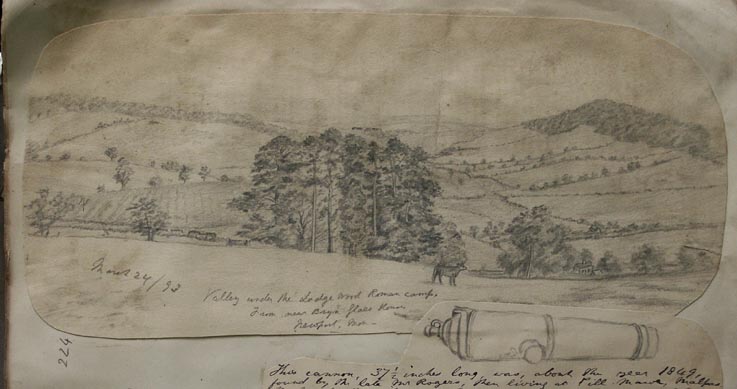This
view of Lodge Wood Roman Camp comes from the 'Scrapbook' of William Henry
Greene. The scrapbook is in the collection of Pontypool
Museum; this image is copyright © Newport Past 2004. The volume
was photographed by arrangement with Torfaen Museum Trust - the project
being financed by the sponsorship of Steve Thomas Financial Services.
For information about W H Greene and a large selection of sketches from
the book visit our website NEWPORT
PAST.
The
cannon is interesting, and here is the full text, handwritten by William
under the sketch:
This cannon 37½
inches long was, about the year 1849, found by the late Mr Rogers, then
living at Pill Mawr Malpas. It lay by the side of a well, in a wooded
watercourse which runs down the hillside, from opposite Mount Pleasant
Cottage (Mrs Brind's), on the Old Caerleon Road, down to the river Usk
near Pill Mawr (now occupied by Mr Scard). Mr Rogers sold it for 10
shillings to the late Mr Jacob Nicholas, of Malpas Villa; and it remains
in Malpas Villa, in the possession of Jacob's nephew. It seems to have
been abandoned by Royalist or Parliamentary troops, when marching between
Caerleon and Newport. A cannon ball was, some years ago, found by Mr
William Edwards, of Bassaleg, who now, 82 years old, sweeps Tredegar
Park. It was in a rabbit hole, near the side of the Bassaleg Road, below
Tredegar Park, but on the cemetery side of the road. These things indicate
the route of the troops in the Civil Wars.
It
would have been wise for troops making their way between Caerleon and
Newport, whether advancing or retreating, to use 'the Old Roman Road'
or 'Pill Mawr Road' as, by following that route, there were no bridges
to cross. The other route (via Christchurch) would necessitate crossing
both Caerleon Bridge and Newport Bridge - both made of wood in those
days - where troops were more vulnerable to attack or delaying tactics. Another
of W H Greene's sketches, King Arthur's Round Table,
can be seen in the Caerleon Net Archive. |

